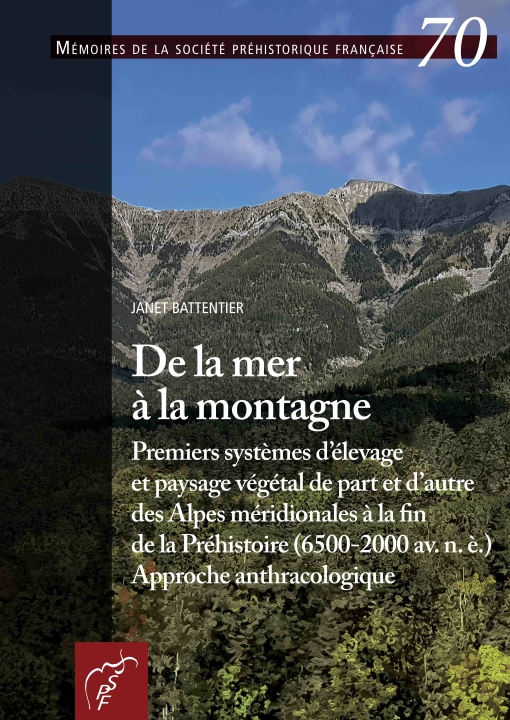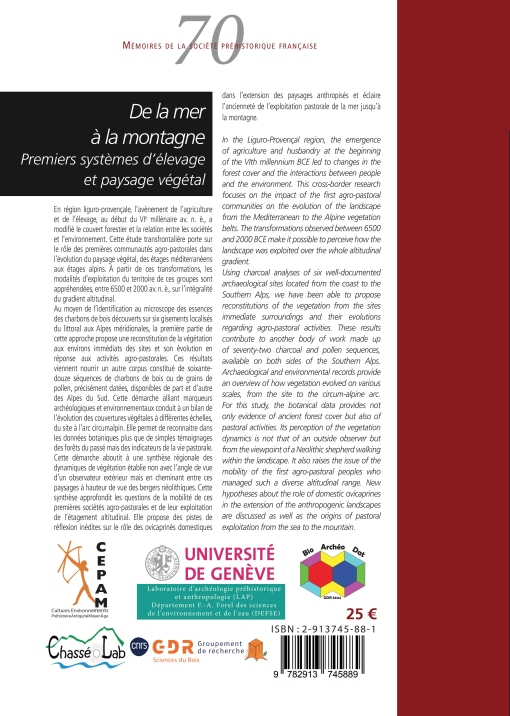M70 (2022) - De la mer a la montagne. Premiers systèmes d'élevage et paysage végétal de part et d'autre des Alpes méridionales. la fin de la Préhistoire (6500-2000 av. n. è.) - Approche anthracologique de Janet BATTENTIER
Résumé :
En région liguro-provençale, l'avènement de l'agriculture et de l'élevage (début du VIe millénaire BCE) a modifié le couvert forestier et la relation entre les sociétés et le milieu qu'elles exploitent. L'analyse anthracologique de six sites archéologiques répartis du littoral jusqu'à 1000 m d'altitude et occupés entre la fin du Mésolithique (Castelnovien) et le Néolithique final (ca 6500-2000 BCE) précisent les modalités de ces évolutions, venant combler les lacunes chronologiques, géographiques et sitologiques d'un large corpus préexistant (78 séquences, anthracologiques et polliniques, en contexte archéologique ou naturel).
De part et d'autre de l'arc liguro-provençal, des dynamiques de végétation relativement similaires se traduisent de façon variable en termes de paysages. Au Castelnovien et à l'Impressa (6500-5600/5400 BCE), les futaies denses et diversifiées prédominent sur un large gradient altitudinal. Dans les basses terres et en altitude, les milieux ouverts, sans doute plus propices aux activités de subsistance (chasse, pastoralisme, agriculture) semblent toutefois préférés par les derniers mésolithiques et les premiers néolithiques.
A partir de la seconde moitié du VIe millénaire BCE, de la méditerranée aux étages alpins, les premières atteintes anthropiques sur le couvert forestier favorisent l'augmentation discrète des végétaux tolérant l'ouverture du milieu et le recul des taxons plus sensibles. Bien que ce processus se renforce progressivement, à toutes les altitudes, sur fond de diversification de l'exploitation du territoire, des séquences anthracologiques attestent du maintien des chênaies caducifoliées dans l'arrière-pays jusqu'au Néolithique final. Ainsi, au fil du Néolithique, l'ouverture anthropique du milieu se déploie sous forme d'éclaircies, de plus en plus répandues mais qui demeurent localisées. Le recul des formations forestières, la baisse de leur diversité et l'essor des taxons de milieux ouverts témoignent directement d'un changement des paysages débuté sans doute en amont, par la modification de l'apparence des forêts (taillis vs futaies). Ainsi, le paysage végétal actuel trouve sa genèse dans les pratiques néolithiques.
Mots-clés : Néolithique, paysage, anthracologie, dynamique de végétation, pastoralisme, Holocène, Méditerranée nord-occidentale.
Abstract:
FROM THE SEA TO THE MOUNTAIN: INITIAL FARMING SYSTEMS AND VEGETAL LANDSCAPE ON EACH SIDE OF THE SOUTHERN ALPS AT THE END OF THE PREHISTORY (6500-2000 CAL. BCE) ANTHRACOLOGICAL CONTRIBUTION
The Liguro-Provençal region extends from the Mediterranean Sea to the Southern Alps and from the Northern Apennines to the Rhone River. In this coastal and mountainous region, the emergence and the development of agropastoral subsistence economies, at the beginning of the 6th millennium BCE, led to changes as regards interactions between these societies and the landscapes they exploited as well as the composition and the physiognomy of the pre existing forest cover. However, although anthropogenic modifications regarding the composition of the plant cover are largely known, the vegetation dynamic needs to be specified at the regional scale. Furthermore, characterising the impacts of these modifications on the physiognomy of the landscape and on settlement strategies still is a debate. We therefore investigated the modalities regarding the evolution of the landscape's vegetation and the diversity of the territories suitable for agropastoral purposes according to a comprehensive altitudinal gradient. These data made it possible to document the spatial organisation of the Neolithic groups from a new perspective and to look at the process of territorial appropriation, from the sea to the mountains. The present study specifies the modalities of these socio-ecological transformations based on charcoal analyses of six well???documented archaeological sites located in southern-eastern France that were occupied from the end of the Mesolithic (Castelnovian) to the Late Neolithic (6500-2000 cal. BCE). It concerns sites located in various environments ranging from the coast to regions reaching 1000 m a.s.l: Font-aux-Pigeons (Châteauneuf-les-Martigues, Bouches-du-Rhône), the Pendimoun shelter (Castellar, Alpes-Maritimes), «RD 560/RD 28 déviation de St-Maximin» and «le Clos de Roques/Route de Barjols» (Saint-Maximin-la-Sainte-Baume, Var), the Pertus II cave (Méailles, Alpes-de-Haute-Provence), Ponteau (Martigues, Bouches-du-Rhône), and Limon-Raspail (Bédoin, Vaucluse). These temporary and semi-permanent occupations could be precisely radiocarbon dated. As a result, this research has filled previously existing gaps regarding chronological, geographical and settlement patterns. Examination of a large body of charcoal and pollen data (78 sequences from archaeological and natural contexts) makes it possible to propose nuanced scenarios on landscape evolution across the Liguro-Provençal region and their relation to human practices. The key contribution of this body of data relies on the combination of sequences from archaeological sites and of sequences from natural contexts. Thanks to the recently improved chronological setting, it enables us to link, spatially and temporally, the environmental data and the socio-economic data related to the different populations that succeeded each other during the Neolithic. An ecological and phytosociological approach of the archaeobotanical data makes it possible to characterise the vegetation dynamic at various scales (from the site scale to the micro-regional and regional scales), focussing on the temporalities of the processes and on the variation of the landscapes, as well as on their effects on the organisation of the Mesolithic and Neolithic societies.
This diachronic and multiscale reconstruction reveals that while vegetation dynamics seem relatively synchronous across the Liguro-Provençal region, their translations in terms of composition and physiognomy of the landscapes are more variable. During the Castelnovian and Impressa periods (6500-5600/5400 cal. BCE), besides the predominance of forest taxa such as deciduous oak (Quercus deciduous), elm (Ulmus sp.), and lime (Tilia sp.), we highlighted the expansion of fir (Abies sp.), which supports the importance of dense, diversified and sub-mature forests, on a broad altitudinal gradient. Open landscapes (characterised by evergreen taxa and light-demanding conifers) also prevailed in the lowlands and at high altitudes. These open landscapes appear to have been more attractive for settlement than fir forests, for both, Mesolithic hunter-gatherers and Early Neolithic farmers, maybe because they are more favourable for the main subsistence activities of these groups (hunting, farming, pastoralism). From the second half of the 6th millennium BCE on, there was a slight rise in plant-types that are more competitive in case of an opening up of the canopy and a decrease of taxa that are more sensitive to open conditions (mainly fir and deciduous oak) as a response to the first anthropogenic disturbances of the forest cover. Depending on the vegetation belt, this benefited mainly to buckthorn and/or phillyrea (Phillyrea sp./Rhamnus alaternus), evergreen oak (Quercus sempervirent), box-tree (Buxus sempervirens) and later, in the highlands, beech (Fagus sylvatica) and spruce (Picea abies) as the opening up of the forests and their replacement by more disturbance-adapted formations growing in the form of coppices increased through time. This process unfolded concomitantly with a diversification of the territories (lowland to upland) and the wood resources exploited by human populations. A staged exploitation of the environment developed in concordance with the increase of anthropogenic pressures related to the expansion of agropastoral systems. However, anthracological sequences from sites such as Limon-Raspail and Saint-Maximin-la-Sainte-Baume provide evidence of the maintenance of deciduous oak forests in the hinterland until the Late Neolithic. Thus, although the thinning of the forest cover spread progressively over the course of the Neolithic, it seems to have remained spatially restricted to rather limited areas.
The linking of different types of sequences in the different microregions makes it possible to gain insights into the vegetal landscape around and between the sites, in five development stages (stage 1: steppe formation; stage 2: forest optimum; stage 3: anthropogenic
opening of forest cover; stage 4: predominance of open formations;
stage 5: growth of the forest cover). Although the phasingis valid for the entire area, its expression in terms of vegetation dynamics proved to be polymorphic. Depending on the areas of the Liguro-Provençal region, the taxa that participate to each stage of the vegetation dynamic may vary. Moreover, the trend towards an opening up of the canopy is neither linear nor unidirectional since it depends on the cycles of decline and recovery of the economic activities. For example, during the Late Neolithic in the lowlands, pre-forest taxa often develop in under-exploited lands, resulting in an increasingly mosaic-like landscape. At a regional scale, this evolution appears to be arrhythmic, since around some sites the vegetation evolves directly from dense forests to widespread open environments due to drastic anthropogenic changes.
Furthermore, we propose that the trees habit, and therefore the appearance of the landscape (e.g. high forest vs. coppices) could have been modified by humans long before the changes in the vegetal composition became strong enough to be detected by pollen or charcoal analyses.
Changes in the vegetal landscape concern a large altitudinal range. Thus, we questioned the origin of the staged exploitationof the territory and tried to identify what triggered theconquest of the highlands. Field data concerning the behaviour of modern caprine herds shed a new light on the paleoeconomicand paleoenvironmental indicators of the staged land exploitation.
The hypothesis can be advanced that the 'climbing' behaviour of grazing herds together with the exploratory and independent nature of goats may have been one of the factors explaining early extensive exploration of the uplands by the first agropastoralists who settled on the coast. A holistic approach is necessary to discuss issues such as pastoral mobility. Obviously, archaeological and paleoenvironmental indicators are needed on a large altitudinal range, but the input of ethological data also contributed to feed the debate.
Keywords: Neolithic, landscape, charcoal analysis, vegetation dynamic, pastoralism, Holocene, north-western Mediterranean.
Société préhistorique française, 2022, 144 pages, 25 ? - ISBN 2-913745-88-1
(EAN : 9782913745889) - Ref : M70
(Mémoire 70)
Stock disponible : 156






